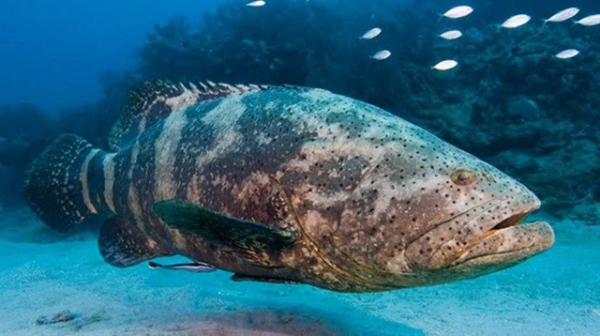
Florida’s Fish and Wildlife Commission will take up a prickly ruling on allowing limited harvest of Goliath grouper later this spring.
Basically, the FWC is proposing an extremely limited harvest of Goliaths, the giant grouper found both inshore and off throughout Florida waters, primarily for research on age, growth and diet.
The proposal would allow a take of just 200 fish per year statewide, which clearly won’t make any difference on an overall population that even the most pessimistic researchers agree has grown remarkably over the 32 years the species has been closed to harvest.
Part of the reason the harvest is being considered is that many reef fish anglers are complaining that the many giant Goliaths now on some reefs make it very difficult to get an edible snapper, gag or red grouper aboard—they gulp down the hooked fish and either break the line or bend out the hooks with their enormous weight.
Many Goliaths over 100 pounds are now found off both Florida coasts, and some fish approaching 500 pounds are being caught and released by anglers who specialize in their pursuit. These giants, no doubt about it, do eat hooked fish regularly.
Unfortunately, the proposed harvest won’t do these anglers much good because the size limit for Goliaths to be taken is 20 to 36 inches. These are not the giants that are eating reef anglers’ hooked fish.
Researchers at the Florida State University Coastal and Marine Laboratory, who have done most of the research on the species over the last 30 years, note that although Goliath numbers are much better today than they were before closure, the species still has not fully recovered, and they pretty much universally oppose any harvest at this time.
The FSU researchers point out the theory that Goliaths are eating all the reef fish on some spots is just plain wrong. In fact, they know from hundreds of hours of underwater observation that reefs with abundant Goliaths also have abundant snappers, groupers and other reef species—the fish swarm where habitat is best.
So how come some well-known good numbers don’t produce like they used to?
Possibly because they are well-known good numbers.
Now that just about everybody with an offshore boat has a really good GPS/sonar or two aboard, finding the good spots is a no-brainer. And though the limits are low, when I catch my limit and than an hour later you pull up and catch your limit and an hour after that somebody else pulls up and catches their limit, then the next time we come back the fishing is not so hot.
The Goliath’s didn’t eat the reef fish: we did.
Under the FWC proposal, the season would be open March 1 to May 31 in all Florida waters except those of Palm Beach county south through the Atlantic coast of Monroe county.
All anglers taking a fish would have to submit harvest and biological information to FWC.
There would be a $10 fee to get into the drawing for the 200 permits—basically enough to pay for the program.
One somewhat controversial part of the proposal is that those who get the permits have to pay a $500 fee to actually buy the tag to make the harvest.
The fee seems a bit excessive. It will assuredly limit the harvest to well-to-do anglers, or those who really, really want to taste Goliath grouper.
Nothing wrong with that in the private sector of a capitalist nation, but you have to wish that the toll would be a bit more affordable when put forth by a state government agency that’s usually very sensitive to the needs of outdoorsmen at all levels of success.
In any case, if you want your shot at a Goliath—or if you think the season should remain closed—now is the time to make your opinion known to FWC.
Frank Sargeant
Frankmako1@gmail.com